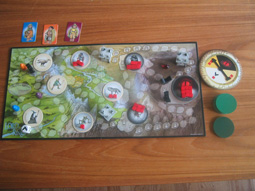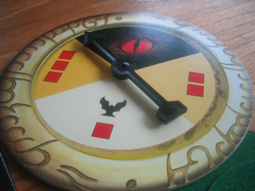PROS
Easy to setup, instruction manual concise, easy to play, good for kids.
LOWS
Fighting can become a bit boring with the spinner.
OVERALL
A simple game that any LOTR junkie will love.
Home Gaming Digital Lifestyle Cheats Downloads Upcoming Product Finder
PROS
Easy to setup, instruction manual concise, easy to play, good for kids.
LOWS
Fighting can become a bit boring with the spinner.
OVERALL
A simple game that any LOTR junkie will love.
 |
|---|
A board game by Eagle Games that is meant to be a kid's game? Whoa… So it's like… easy!? Wow, maybe this time I will actually be able to play the game instead of stare at the instruction manual for two hours and not accomplish anything. What a thought. This time, the name of the game is Lord of the Rings. Ring a bell -HA-? Well, that's because it is based on the Lord of the Rings movie series. If you are a LOTR junkie, you may have just met your match; a childish board game that has you lead your little wooden colored hobbit to victory by defeating the Dark Lord Sauron!
In the LOTR board game, you play as a hobbit. The object of the game is for you to battle your way throughout the game board and to end up reaching the Dark Lord Sauron and defeating him in battle. The first hobbit to do this is the winner. Before you fight him, you are going to have to get past other enemy tiles, such as the Orc, Wolf, and Uruk-Hai. Fighting is done by use of the spinner and the enemy cubes, small wooden red cubes. Even though you will have to deal with your fair share of enemies, you will also encounter friendly tiles that in the advanced game can help you out quite a bit.
In order to allow children aged six and up to play this game with their families, there are two different board game versions; beginner's and advanced. If you are over 9, you are probably ready for advanced. Otherwise, beginner is a good way to start.
I am going to talk about the advanced game, because it is the same as the beginner game but adds a few other features. After selecting your colored hobbit piece and the corresponding “hobbit card,” you place your piece on the circle at the beginning of the game board. You will use a die to determine how many spaces your hobbit can move at a turn. The die is standard, except for the fact that a picture of the “Flying Nazgûl” replaces the ‘one'. Like in the LOTR movies, the Flying Nazgûl is a dragon-like creature used by the enemies of the Hobbit. If the die lands on the picture of the Flying Nazgûl, you get to take the Flying Nazgûl piece (there are three of them) and use it to block the path of your opponent. If you role a number instead of the Flying Nazgûl, you can move any number of spaces equal to or less then the given number, including the option to not move at all.
In order to move across the board, you are going to have to pass over tile cards, which have the pictures of both friends and enemies on them. In order to win over friend tiles or to defeat enemy tiles, you are going to have to use the spinner. First we will discuss the spinner in general.
 |
|---|
There are four different sections on the spinner; one cube and the Flying Nazgûl, two cubes, three cubes, and the Dark segment. If you encounter a friendly unit, landing on anything but the dark segment wins that friend for you. Enemy tiles have a given number of red cubes listed. Your object is to eliminate each of the red cubes, so the enemy is defeated. If you land on the dark segment while fighting an enemy, your turn ends. By defeating an enemy or winning over a friend, your hobbit can pass to the other side of the tile, allowing you to come closer to Mount Doom, where your ultimate fight with Sauron will take place.
One feature exclusive to the advanced game is the use of the Dark Towers. While getting nearer to Mount Doom, spaces on the board with pictures of the Dark Castle appear more frequently. If your turn happens to end on a space with the dark castle, your opponent has to take the Palantír (represented as a red marble) in his hand, and then hold out both hands. Your job is to choose which hand the Palantír is not in. If you pick the hand with the Palantír in it, you are now imprisoned in the Dark Castle, and cannot move until your next turn. Upon your next turn, you must roll a number, and then can move that many spaces away from the dark castle. If you happen to not pick the Palantír from your friend's hand, you have saved yourself from imprisonment.